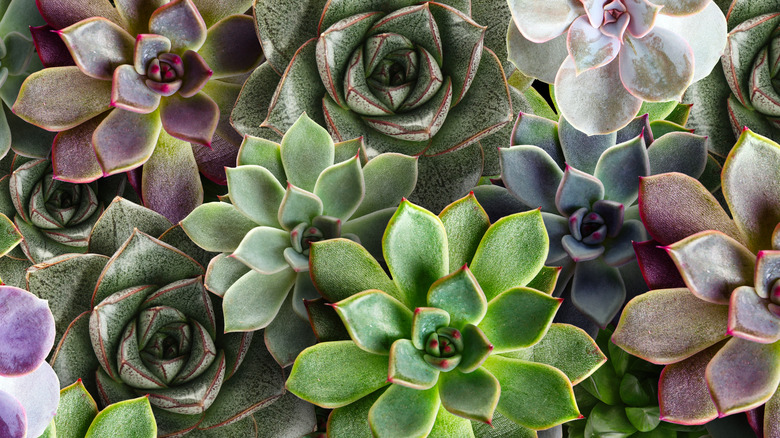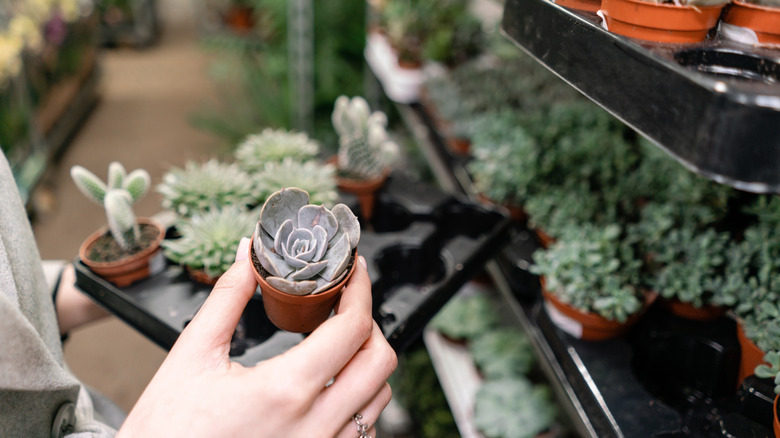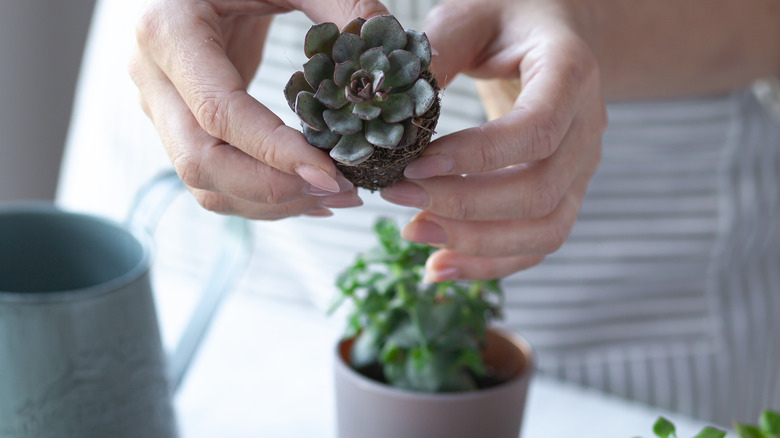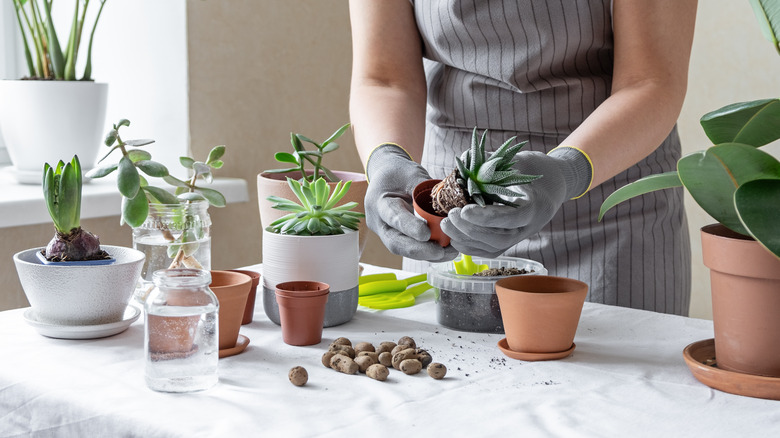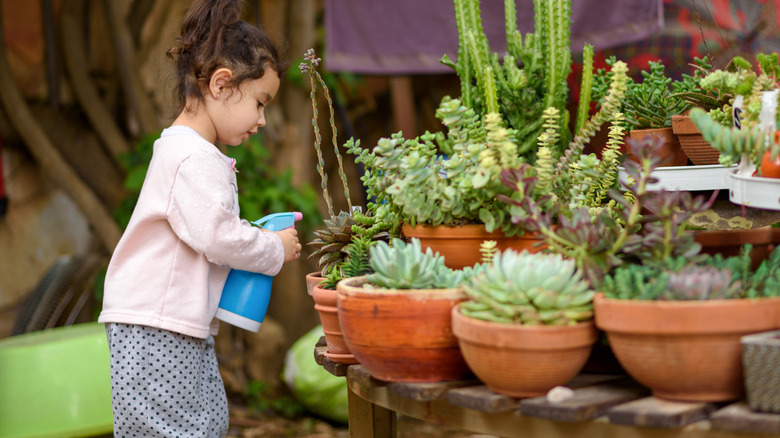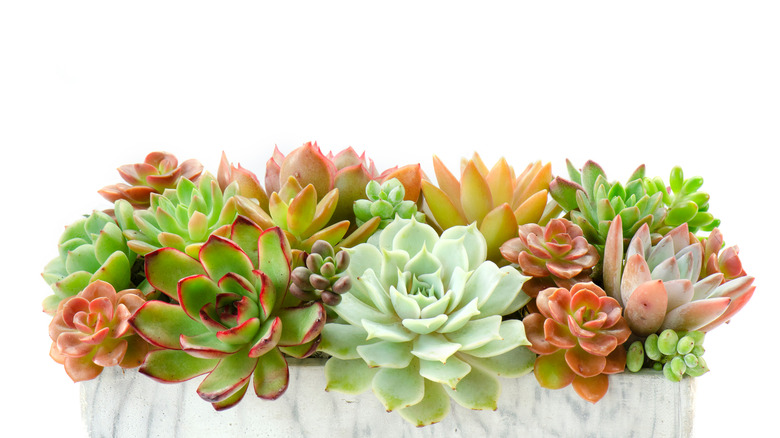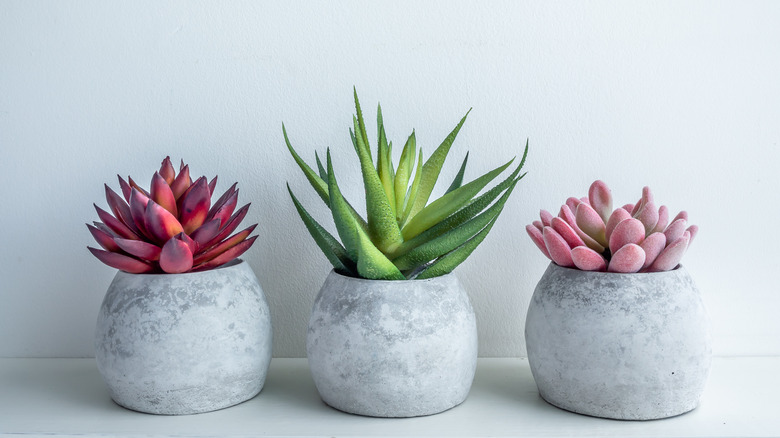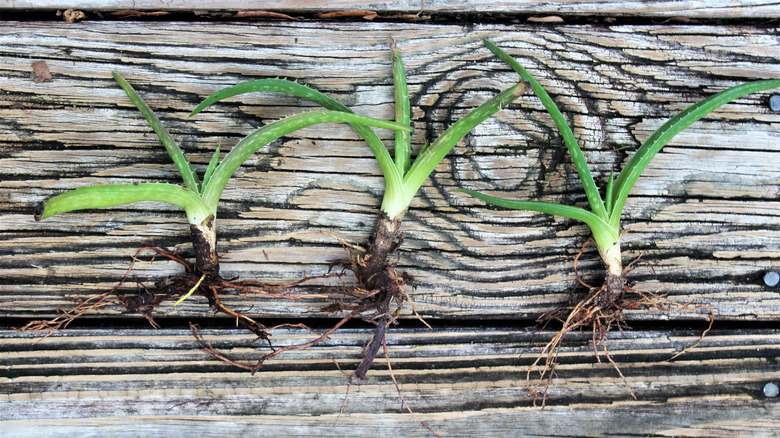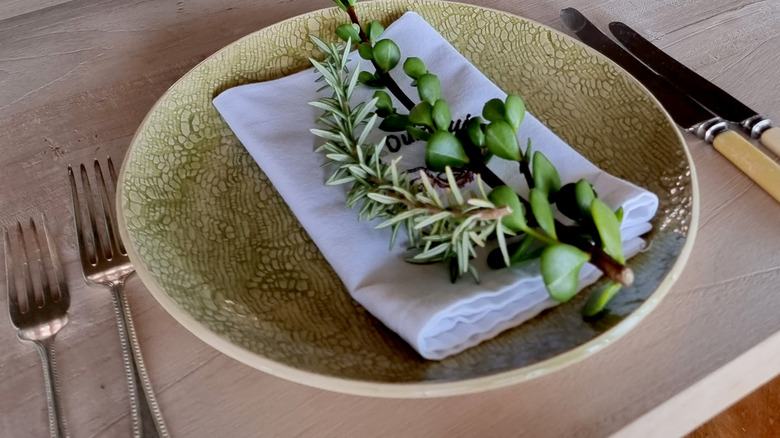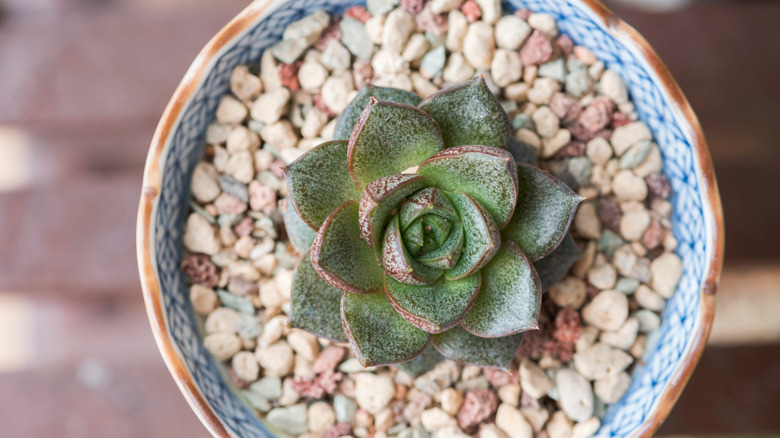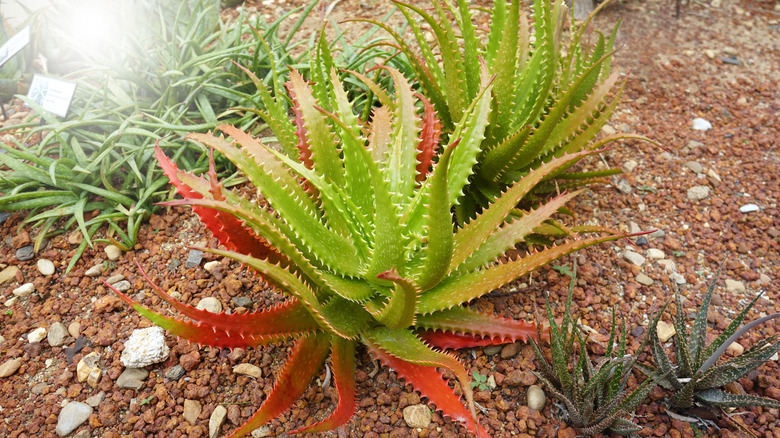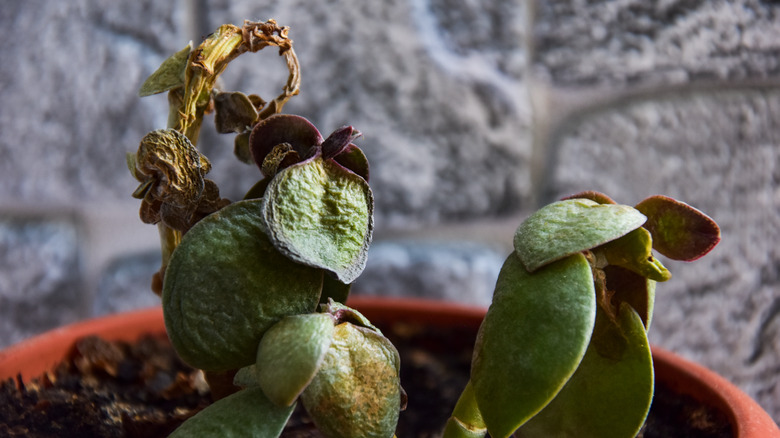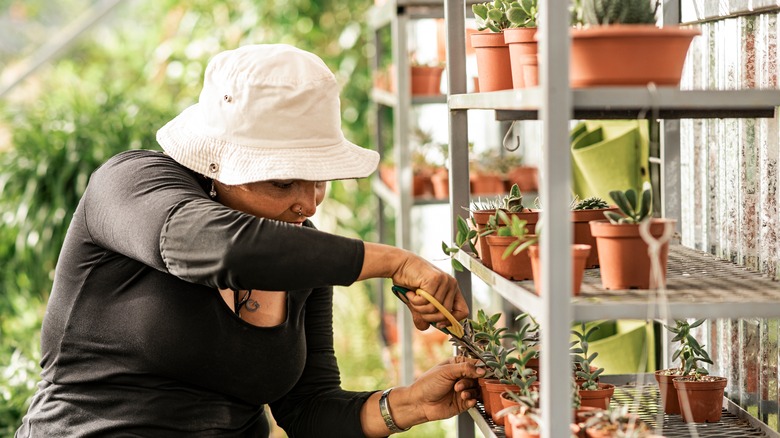Succulents: Everything You Should Know Before Planting
We may receive a commission on purchases made from links.
The drought-resistant succulent plant (scientific name: Crassulaceae) is a low-maintenance plant that stores water in its leaves or stems, says Gardening Know How. Succulents are known for being uncomplicated, hardy plants that can take a lot of sun and occasional cold snaps, and can withstand the negligence of a new gardener just learning the ropes. That said, for plants that require very little fussing, succulent taxonomy is anything but simple.
Succulents come in a variety of shapes and sizes, though membership to the Crassulaceae family means they usually have five leaves and are symmetrical, says Succulent Scientific. From there, succulents are broken into clades (ancestral groups), and a big one is Acre. The Acre succulent group has more than 500 species. The two dominating genera (that's genus, plural) of the Acre succulent group are the Sedum and Echeveria. Over the last century, scientists have argued and ultimately reclassified several plants that were once classified as a subgenus of Sedum to their own genus. Echeveria has likewise been subject to species moving in and out of its classification.
Fortunately, succulents save the plot twists for the scientists and offer gardeners low-maintenance, straightforward plant color, variety, health benefits, and more. Plus, they are easy to breed and grow. Keep reading for a guide on how to care for your own indoor or outdoor display of succulents.
Where to buy succulents
When you've got succulents on your shopping list, chances are you'll suddenly notice them everywhere you look. Supermarkets and garden centers are usually full of them, and big box stores like Lowe's, Home Depot, IKEA, and Target are all sure to stock them as well. Deciding where to buy them is a personal choice, but here are a few tips.
For the absolute beginner gardener, it's worth it to go to a local nursery or greenhouse. This will allow you to speak with a professional and pick up some confidence that you've chosen well and your plants will thrive. This will also be the best place to pick up some succulent-specific potting mix for when you're ready to repot.
Grocery stores, larger garden centers, and name-brand stores will likely have a nice array of options. They tend to be inexpensive, and in tiny pots, so you might pick up a few. Look for plump, healthy plants with no decaying or diseased leaves. It's fine if the soil is dry so long as the plant has not incurred any damage.
Once you've settled on a few varieties that you really like cultivating in your home, you can transition to purchasing succulents online from a reputable source. Sublime Succulents explains that some retailers may offer the best bargains, but others will send you the best plants. Quality packaging and efficient shipping practices are the keys to receiving a healthy plant through the mail.
How to use succulents in a garden
The name succulent comes from the Latin word for juice, says Plant Care Today, which stands to reason because they store water in their leaves or stem. That means their root systems are shallow, so overwatering can cause quick root rot. To avoid this, consider grouping succulents in a large pot with other succulents that have similar soil and watering needs. If planting directly into your garden outside, note that succulents require very little rainfall, as much as 50% less than most other flowers and shrubs, says Happy Sprout, so plan accordingly. Growing a jade succulent plant, for instance, can create a lavish hedge for your garden since they can be maintained at around 4 feet tall, says Gardening Know How, but that is only if you live in warm, dry conditions, as well as have a garden with porous soil.
If you have colder weather, you can still consider succulents an option for your garden, says Sublime Succulents. The pink ice plant succulent, for instance, can bring its pretty lilac bloom in the spring and still stay in the ground through colder weather – though you should consider covering it. Some succulents, like sedum groundcover plants, can also handle winters, so long as they are planted in full sun, says Succulents Addiction. These clumping varieties can flower into a dense mat of color without becoming invasive, thanks to shallow roots that are easy to pluck up on a gardener's whim.
How to grow succulents
According to The Spruce, succulents are particularly easy to grow. Depending on the variety, growing your succulent requires as little as a snip of leaf or bit of stem from another succulent, and planted just like that, it will root fairly quickly. One example is the autumn joy stonecrop. Tuck its stem directly into the ground, or set it aside in a small container with porous potting mix that you keep faintly damp. It is time to plant when it gives a bit of resistance and has fastened into the soil.
In the case of the autumn joy, you may also consider dividing your plant in the spring. First, water your topsoil, then cut your plant down to 6 inches above the topsoil. Using a sharp garden tool, dig up your succulent clump, tug it apart gently, and replant those clumps, watering completely after planting.
If your penchant is for mini succulents, consider the rose succulent. These are little, topping out at a mere 8 centimeters tall, says World of Succulents. Unlike the autumn joy stonecrop, rose succulents propagate by way of sprouts, or "pups" that you snip, let callous over for a few days and then replant, according to Living Succulents. Also, unlike other succulents, this little mini goes dormant in the summer, so they will need extra watering during the winter months.
How to care for succulents
The variation of succulent needs, from differing dormant periods to varied temperature demands, can overwhelm gardeners who were counting on the succulent reputation for low maintenance to mean effortless. However, if you lock down the basics of moisture method, easy-drain soil, and the right light, you will be able to pivot between succulent varieties with more confidence, according to HGTV.
Start with the method you use to water your succulents. Remember that these are plants that like water in a desert way, which is nothing, and then a lot. When your succulent needs water, soak it thoroughly. After that, wait until the soil is dry down several inches, if not completely dry, before soaking again. Next, think about how much sun your succulent is getting, which for most succulents should be up to eight hours a day. The trick is that certain succulents need indirect, less intense light, says Garden Beast, while others like to be awash in sun with no shade. Likewise, a few succulents can handle chilly temps but not frost, says Sublime Succulents.
One way to verify what sun and water methods your succulent calls for is an app, like Drought Smart Plants. It runs down the specific sun and water needs for most succulents, includes a photo, and also warns if your succulent is toxic for your house pets.
Succulent varieties
Succulents mostly hail from parts of Africa, although some, like the perennial blooms in the family Commelinaceae, originate from parts of the West Indies all the way to southern Canada, says Succulent Alley. Here are five examples of succulent varieties.
- Sedum – one of the largest genera in the Crassulaceae family, sedums have perennials, herbs, shrubs, and annuals that bloom. It contains either 600 species or 400-500 species, depending on your scientific source. Its diversity makes it nearly impossible to precisely differentiate these plants except to say they typically have water-retaining leaves and stems.
- Kalanchoe – this genus is smaller but tall (Kalanchoe beharensis can grow to 20 feet tall, though most top out around 3 feet). Kalanchoe has 125 tropical species originating from Madagascar.
- Echeveria – another dominant genus in the Crassulaceae family, Echeveria comes from Central America and northwestern South America. Echeveria plants are a succulent that like a little shade and even chilly temps.
- Aeonium – this genus has 35 species of subtropical Crassulaceae succulents. Its name is Greek for "ageless" (aionos).
- Huernia – this five-lobed bloom looks a lot like its sister genus Stapelia but features more funnel-shaped flowers. It originates from Eastern and Southern Africa and Arabia.
Which succulents are the easiest to take care of?
It's normal to feel nervous when introducing a new type of plant into your home. One of the great things about all succulents is that, for the most part, they survive just fine with a fair amount of neglect. Even so, some are easier to take care of than others, and these might be the varieties you want to add first.
Aloe vera (Aloe barbadensis) is a very common houseplant, primarily because almost anybody can keep it alive. When you get yours home, find it a very bright spot and position it so the light it receives is indirect, as per Stockslager's. Too much harsh sun will cause it to dry up prematurely. Aloe is fun; you can snap open a leaf and use the gel to soothe mild burns or cuts. Keep it away from the pets, though. The ASPCA confirms that it can be mildly toxic when eaten.
Jade (Crassula ovata) is another popular choice that can be successfully cared for quite easily. It will also need 4 to 6 hours of bright, indirect sunlight per day (via Gardenine). Jade plants are also easy to propagate. A single leaf from a healthy plant can be grown into a whole new plant. And wouldn't a homegrown baby jade make an absolutely adorable housewarming gift?
Echeverias (Echeveria spp.) come from a large genus of succulents that produce striking rosettes. There are many colorful options, and they can handle some shade.
How to repot and replant succulents
Succulents sound an alarm of sorts when it is time to propagate. For instance, the Echeveria rosettes will begin to lose their compact shape, says Succulents and Sunshine. This is indicative that, among other things, it is time for cutting. You can snip the top with any sharp cutter, leaving behind a few leaves on the remaining stem. Set your cutting aside to callous, typically a few days, then tuck it into fresh well-draining soil and water it thoroughly. The new succulent should sprout within a few weeks but often much sooner.
Another telltale sign your succulents have outgrown their flowerpot, according to MasterClass, is root shoots that begin poking through the holes under your drainage pot. This, along with any notice of soggy soil or mold on the surface of your succulent's soil means it is time for a bigger pot and fresh soil.
If your succulent is sprouting "pups" you want to replant but are not sure when, Gardening Know How suggests letting them grow to the size of a quarter as a good rule of thumb. The best time to repot succulents is just before their growth season, says Succulents Box. Keep in mind that succulents do not all have the same growing season, so be sure to double-check if yours is a summer or winter dormant succulent.
Plant information specific to succulents
When you are dealing with a family of plants that can range from 62 feet tall (like the African Baobab) to so teeny they thrive in pots as little as a few inches (like Aeonium dodrantale), you already have a lot of specificity circling around how to plant, care for, propagate and generally handle succulents. However, there is even more to the succulent that makes this an interesting plant.
For one thing, you can eat them, says Succulents Addiction. Proceed with caution because yellow flower sedums are mildly toxic but still edible if cooked appropriately. Red sedum blooms, however, have stems, leaves, and tubers (thick, root-like sprouts) that can be tossed into salads raw. Succulents also help you concentrate, says Red. A study out of the University of Michigan reported retention rates of studying students climbed as much as twenty percent when succulents were nearby. Maybe that is because they also purify toxins from the air, according to NASA.
One succulent to side-eye, however, is aloe vera, which is medicinal for humans, but its sap can cause major gastrointestinal distress to your cat or dog, according to Succulent Plant Care. That said, most succulents are considered non-toxic.
How long do succulents live?
If you can believe it, the lifespan of a succulent can range from a few years to a few centuries; this depends, of course, on which variety you have. CactusWay reports that the longest living succulent was a Saguaro cactus in Arizona (similar to the one pictured above), estimated to be 300 years old before its unfortunate demise in the 1990s. Can you expect your houseplant to live that long? Probably not, but a healthy plant will still have a nice life when given proper care.
According to Epic Gardening, only a handful of succulent species have been studied closely enough to have an expected life span attributed to them, and they vary quite a bite. Your aloe vera may only realistically make it to the age of five, while your well-tended jade may be passed down through generations.
One thing that does keep these plants alive longer is that many of them shoot up new baby plants around the base of the original mother plant. In this way, they basically replicate themselves, and the offshoots often look like they are simply part of the mother. Anytime you find yourself with a succulent you like, take a few cuttings to grow new plants. That way, you'll be able to keep the line going for the long haul, even if the original faces a setback or dies prematurely.
Should you add rocks, sand, and pebbles to your succulent pot?
Most plants benefit from a top dressing of organic compost, nutrient-dense potting mix, or even worm castings. However, inorganic options like pebbles and rocks are the better choice with succulents. Per The Succulent Eclectic, a thin layer will provide a slew of benefits by regulating soil temperature, protecting the roots, and preventing weeds from growing. Furthermore, the rocks can offer some much-needed structural support for young succulents as they continue to grow their anchoring roots down into the soil.
The Succulent Eclectic suggests getting a little artistic when picking out your top dressing. Things like fire glass, quartz, and sea shells will do the trick and look pretty to boot; just note a few considerations. Beach sand may contain enough salt to harm a plant, so rinse it with clean water before applying it. Colored pebbles could be stained with a dye that runs. Aquarium stores are one of the best places to look for appropriate materials that will come in stunning colors and are sure to be plant-safe.
Another benefit of an inorganic top dressing is that it prevents insects from laying eggs. In fact, Growstone makes a product called Gnat Nix, which is made out of recycled glass and designed to do just that. It's a chemical-free and nontoxic way to strongly encourage those moist-soil-loving egg layers to move along and find somewhere else to spawn their young.
What to do if a succulent starts turning red or brown
A succulent with leaves turning red or brown is not necessarily in trouble. It could happen due to environmental conditions such as an intense level of light exposure or a significant temperature change, explains Succulent Plant Care. Some, like the sunset aloe (Aloe dorotheae) seen above, naturally turn from yellowish-green to orange-red in full sun.
In many cases, it's normal for your succulent to change color, and you can trust that they're built by nature to withstand some intensely harsh conditions. However, there are certain stressors to be aware of that you, as the grower, may be responsible for and/or able to control. For instance, plants receiving too much or insufficient water or improper nutrition are likely to change color. Adjust your watering schedule and consult a local nursery regarding appropriate fertilizer if you are concerned that your plant is in trouble. Otherwise, enjoy the chameleon effects.
How to tell if you've overwatered or underwatered your succulent
In regard to botany, the term succulent is defined as a plant that has fleshy tissues that conserve moisture (via Merriam-Webster). These tissues store water in the leaves, which means succulents do not depend on roots to search for moisture in the ground and can, therefore, survive in stark environments with very little water. Drought is normal everyday life for a succulent out in nature, confirms Succulents Box. While it's certainly possible to leave a plant too long without water (you'll know when leaves are dry and shriveled), it's much more common to have a sick succulent due to over-watering.
Key signs of too much water are translucent, soggy, and/or yellowing leaves. When they are left to absorb more water than they can store, the leaves become damaged and begin to die off. You may also see black spots, which are signs of rot. The recommended course of action from here is to salvage any unaffected leaves and prepare them for propagation.
To avoid giving your plants more water than they can handle, HGTV says to mimic the natural environmental conditions of the desert by following a pattern of drenching and drying. Soak them all the way through as if heavy rain is pouring down, then leave them alone until they are completely dry. Only then will you water them again in the same fashion. Generally speaking, watering succulents via ice cubes is ill-advised.
Should you remove dead leaves from a succulent?
The short answer to whether you should remove dead leaves from a succulent is yes. According to Succulents and Bugs, just as leaves that are changing color do not necessarily signify a sick plant, not all dead leaves are a sign of distress. Of course, they will die when something is wrong, but leaves will also go through individual stages of life and death naturally.
The two most important reasons to tend to decaying or dying leaves are, first, to keep the plant clear of debris that may block air circulation, and second, to encourage energy away from the dying leaves and towards creating new growth instead. A pot cluttered with damaged leaves can result in soil that stays damp for too long, leading to root rot.
Per Dalla Vita, it should be easy to remove dried leaves. If they don't readily fall off, give them a careful snap, and you should be good. Removing the dead leaves will also help prevent mildew growth and other potential problems and diseases.
